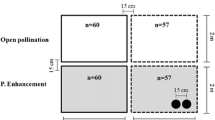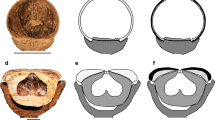Abstract
Fruit abortion has been hypothesized to be a parental means of selective removal of propagules with low viability. In particular, aborted zygotes have been suggested to have developmentally deviant phenotypes, and surviving offspring may therefore give rise to adults with a developmentally stable phenotype. We tested predictions from this hypothesis using acorns of holm oaks Quercus ilex as a model system. Fecundity of oak trees was negatively related to mean fluctuating asymmetry of leaves, and abortion rates were positively related to leaf fluctuating asymmetry in at least one population. Aborted acorns were asymmetric in 83–99% of cases in three samples, while mature acorns were only asymmetric in 57–78% of cases. Acorn asymmetry was unrelated to germination probability and germination date, and had no significant effect on number of leaves, leaf mass, stem mass, seedling height or leaf area of seedlings. However, acorn asymmetry affected the trade-off between number and size of leaves in seedlings. Seedlings from asymmetric acorns showed a positive relationship between acorn size and number of leaves, but no relationships between acorn size and leaf area, while symmetric acorns showed the opposite. A positive relationship between acorn size and number of leaves in spring was found for naturally emerged seedlings that died during their first summer, whereas the number of leaves produced by surviving seedlings did not depend on acorn size. These findings are consistent with the hypothesis that stressed trees selectively abort propagules of low viability, and that developmental selection acts on a measure of developmental instability of fruits.




Similar content being viewed by others
References
Cadée N (2000) Parent barn swallow fluctuating asymmetry and offspring quality. J Avian Biol 31:495–503
Cohen J (1988) Statistical power analysis for the behavioral sciences, 2nd edn. Erlbaum, Hillsdale, N.J.
Díaz M, Pulido FJ, Møller AP (2003) Herbivore effects on developmental stability and fecundity of holm oaks Quercus ilex. Manuscript submitted to Oikos
Fuller R, Houle D (2002) Detecting genetic variation in developmental instability by artificial selection on fluctuating asymmetry. J Evol Biol 15:954–960
Fuller R, Houle D (2003) Inheritance of developmental instability. In: Polak M (ed) Developmental instability: causes and consequences. Oxford University Press, New York
García D, Zamora R, Gómez JM, Hódar JA (1999) Bird rejection of unhealthy fruits reinforces the mutualism between juniper and its avian dispersers. Oikos 85:536–544
Hasegawa M (1995) Sexual selection among peafowl — fluctuating asymmetry and parasite resistance. Bull Assoc Nat Sci Senshu Univ 26:19–26
Kozlowski J, Stearns SC (1989) Hypotheses for the production of excess zygotes: models of bet-hedging and selective abortion. Evolution 43:1369–1377
Leung B, Knopper L, Mineau P (2003) A critical assessment of the utility of fluctuating asymmetry as a biomarker of anthropogenic stress. In: Polak M (ed) Developmental instability: causes and consequences. Oxford University Press, New York
Marshall DL, Ellstrand NC (1988) Effective mate choice in wild radish: evidence for selective abortion and its mechanism. Am Nat 131:739–756
Mock DW, Forbes LS (1995) The evolution of parental optimism. Trends Ecol Evol 10:130–134
Møller AP (1996) Developmental stability of flowers, embryo abortion, and developmental selection in plants. Proc R Soc Lond B 263:53–56
Møller AP (1997) Developmental selection against developmentally unstable offspring and sexual selection. J Theor Biol 185:415–422
Møller AP (1999) Asymmetry as a predictor of growth, fecundity and survival. Ecol Lett 2:149–156
Møller AP, Cuervo JJ (2003) Asymmetry, size and sexual selection: factors affecting heterogeneity in relationships between asymmetry and sexual selection In: Polak M (ed) Developmental instability: causes and consequences. Oxford University Press, New York
Møller AP, Swaddle JP (1997) Asymmetry, developmental stability, and evolution. Oxford University Press, Oxford
Møller AP, Thornhill R (1997) A meta-analysis of the heritability of developmental stability. J Evol Biol 10:1–16
Møller AP, Thornhill R (1998) Bilateral symmetry and sexual selection: a meta-analysis. Am Nat 151:174–192
Møller AP, Cuervo JJ, Soler JJ, Zamora-Muñoz C (1996) Horn asymmetry and fitness in gemsbok, Oryx g. gazella. Behav Ecol 7:247–253
Mousseau TA, Fox CW (eds) (1998) Maternal effects. Oxford University Press, New York
Petrie M, Halliday T (1994) Experimental and natural changes in the peacock's (Pavo cristatus) train can affect mating success. Behav Ecol Sociobiol 35:213–217
Petrie M, Halliday T, Sanders C (1991) Peahens prefer peacocks with elaborate trains. Anim Behav 41:323–331
Polak M (1997) Ectoparasitism in mothers causes higher positional asymmetry in their sons: implications for sexual selection. Am Nat 149:955–974
Polak M, Starmer WT (2001) The quantitative genetics of fluctuating asymmetry. Evolution 55:498–511
Polak M, Opoka R, Cartwright IL (2002) Response of fluctuating asymmetry to arsenic toxicity: support for the developmental selection hypothesis. Environ Pollut 18:19–28
Pulido FJ, Díaz M (2002a) Dinámica de la regeneración natural del arbolado de encina y alcornoque. In: FJ Pulido, P Campos, G Montero (eds) La gestión forestal de las dehesas. IPROCOR, Mérida, Spain, pp 39–62
Pulido FJ, Díaz M (2002b) Recruitment of holm oaks: disparate determinants of regeneration in Mediterranean forests and dehesas. Manuscript submitted to Ecological Monographs
Pulido FJ, Díaz M, Hidalgo SJ (2001) Size-structure and regeneration of holm oak (Quercus ilex) forests and dehesas: effects of agroforestry use on their long-term sustainability. For Ecol Manage 146:1–13
Rice KJ, Gordon DR, Hardison JL, Welker JM (1993) Phenotypic variation in seedlings of a keystone tree species (Quercus douglasii): the interactive effects of acorn source and competitive environment. Oecologia 96:537–547
Rosenthal R (1991) Meta-analytic procedures for social research. Sage, New York
Sabaté S, Sala A, Gracià CA (1999) Leaf traits and canopy organization. In: Rodà F, Retana J, Gracià CA, Bellot J (eds) Ecology of Mediterranean evergreen oak forests. Springer, Berlin Heidelberg New York, pp 122–133
Sakai S, Harada Y (2001) Sink-limitation and the size-number trade-off of organs: production of organs using a fixed amount of reserves. Evolution 55:467–476
Searcy KB, McNair MR (1990) Differential seed production in Mimulus guttatus in response to increasing concentrations of copper in the pistil by pollen from copper tolerant and sensitive sources. Evolution 44:1424–1435
Searcy KB, McNair MR (1993) Developmental selection in response to environmental conditions of the maternal parent in Mimulus guttatus. Evolution 47:13–24
Skalski JR (1987) Selecting a random sample of points in circular field plots. Ecology 68:749
Traveset A (1993) Deceptive fruits reduce seed predation by insects in Pistacia terebinthus L. (Anacardiaceae) Evol Ecol 7:357–361
Traveset A, Willson MF, Gaither JC (1995) Avoidance by birds of insect-infested fuits of Vaccinium ovalifolium. Oikos 73:381–386
Van Dongen S (2000) The heritability of fluctuating asymmetry: a Bayesian hierarchical model. Acta Zool Fenn 37:15–24
Wade MJ (1998) The evolutionary genetics of maternal effects. In: Mousseau TA, Fox CW (eds) Maternal effects. Oxford University Press, New York, pp 5–21
Yezerinac SM, Lougheed SC, Handford P (1992) Measurement error and morphometric studies: statistical power and observer experience. Syst Biol 41:471–482
Acknowledgements
We are very grateful to Hilda Fernández de Córdova (†) and Carlos Marcos for permission to work within their estates. Chema Torres helped us during field work, J. Barandica, F. López and J. V. Zorrilla with leaf measurements and J. Clobert with statistical tests. Comments of M. Polak, G. Moreno and two anonymous referees on earlier drafts were very helpful. F.J. P. was funded by a F.P.I. grant from the Consejería de Educación y Juventud of the Junta de Extremadura while carrying out the field work, and M. D. received a grant for research of the Spanish CICYT while writing the manuscript. This study is a contribution to the project PAC-02-008 of the Junta de Comunidades de Castilla-La Mancha.
Author information
Authors and Affiliations
Corresponding author
Rights and permissions
About this article
Cite this article
Díaz, M., Møller, A.P. & Pulido, F.J. Fruit abortion, developmental selection and developmental stability in Quercus ilex . Oecologia 135, 378–385 (2003). https://doi.org/10.1007/s00442-003-1202-y
Received:
Accepted:
Published:
Issue Date:
DOI: https://doi.org/10.1007/s00442-003-1202-y




